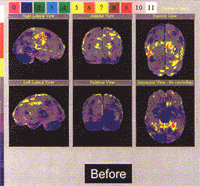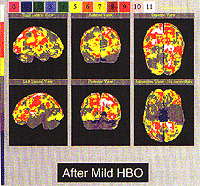What is hyperbaric oxygen therapy?
Hyperbaric oxygen therapy is an effective method of increasing oxygen delivery to diseased and damaged tissue in an effort to enhance healing and recovery of function. It is often an appropriate addition to a comprehensive treatment program including medical, nutritional, and other therapeutic modalities. Hyperbaric (high pressure) delivery of oxygen is a treatment used to increase the amount of oxygen delivered by the bloodstream to tissues throughout the body. Oxygen is required in every cell for normal function and increased amounts may be needed in areas of disease, infection, or injury in order to restore health.


Fig 1. – Pre- and Post- SPECT scans showing remarkable improvement after only 10 hyperbaric treatments.1
How does hyperbaric oxygen therapy work?
Under normal conditions, hemoglobin carries 97% of the oxygen in the circulation and an additional 3% is dissolved in the blood. Oxygen given by mask can increase the saturation of hemoglobin to 100%, but this does not appreciably increase the amount of oxygen dissolved in the plasma. Although this small increase in oxygenation is beneficial, it is minimally effective in the treatment of advanced disease or injury.
The increased pressure in a hyperbaric chamber allows the level of oxygen carried by the plasma to increase considerably and breathing oxygen while in the treatment chamber can further increase the amount of oxygen in our circulation. This rapidly raises oxygen levels in all tissues to enhance energy production and the elimination of accumulated toxins. In disease conditions where inflammation and edema are present, circulation in the tissues involved is compromised and oxygen delivery often does not reach the level necessary for healing to occur. Increasing the amount of oxygen circulating in the bloodstream allows cells in areas of poor perfusion to receive the oxygen necessary for metabolism and decrease the probability of cell death. Even in areas with normal circulation, the amount of oxygen delivered under ordinary circumstances may be insufficient to achieve health. After many injuries, there is an area of tissue that will not recover surrounded by an area that has the potential to recover. Hyperbaric oxygen therapy is often successful in bringing this injured and dormant area back to health.
What conditions might respond to hyperbaric oxygen therapy?
Clinical response to hyperbaric treatment has been reported in a wide variety of conditions. Clients with the following diagnoses often respond to treatment:
-
Autism
-
Concussion
-
Cerebral palsy
-
Multiple sclerosis
-
Tourette’s syndrome
-
Traumatic brain injury
-
COVID-related sequelae
-
Attention deficit disorder
-
Fibromyalgia
-
Chronic fatigue
-
Crohn’s disease/colitis
-
Burns
-
Crush injuries
-
Myocardial infarction
-
Infections
-
Surgical wounds
-
Bone fractures
-
Diabetic ulcers
-
Mitochondrial dysfunction
-
Acne
-
Sports injuries
CARE is a leader in hyperbaric oxygen research
CARE was one of six research centers that participated in a groundbreaking study of the use of hyperbaric oxygen therapy for the treatment of children with autism. A total of 62 children with autism were given either hyperbaric oxygen therapy at 1.3 ATM or placebo treatment.
After 40 hours of hyperbaric oxygen therapy, physicians rated children in the treatment group as significantly improved in overall functioning, receptive language, social interaction, and eye contact. 9 of 30 children (30%) in the treatment group were rated as “very much improved” or “much improved” compared to 2 of 26 (8%) of controls. Dr. Schneider and the other physicians involved in this study were blinded, meaning they were unaware of which children received hyperbaric oxygen therapy and which received placebo treatments. Parents, who were also blinded, reported improvements in overall functioning, language, and eye contact as well as improvements in irritability, repetitive behaviors, and hyperactivity. These improvements were not observed in the placebo group.
The use of hyperbaric oxygen therapy for the treatment of many of these conditions is considered investigational, even though the use of hyperbaric oxygen therapy has a 200 year history. Although recognized and accepted by a growing number of physicians, it is not covered by insurance.
What does the process involve?
The hyperbaric chambers at CARE are spacious enough to accommodate a child and his or her parent. Individuals under 5′ tall are usually able to sit up in the chamber if desired. The procedure is comfortable and painless. A slight pressure may be felt on the eardrums, similar to that felt while on an aircraft. Yawning or swallowing alleviates this pressure sensation. Treatment sessions last 1-2 hours, but may vary according to the diagnosis and individual needs of our patients. In most cases, other treatments should be continued during HBOT, as neurological response to treatment will be optimal while oxygen levels are elevated. The chamber has multiple windows and clients can easily communicate with staff members while in the chamber. Patients often listen to music, read, play, rest, or sleep while undergoing treatment.
What pressure is used during hyperbaric oxygen therapy?
The chambers used at CARE utilize a pressure of 4 psi (pounds per square inch). This is also referred to as 1.3 ATM, which means that once fully pressurized, the pressure inside the chamber will be one third higher than it was before pressurization. This is considered “mild” hyperbaric oxygen therapy, which offers considerable therapeutic benefit to many clients without the potential side effects of treatment at higher pressures.
How many treatment sessions will be needed?
Most conditions require a series of treatments to achieve meaningful and lasting results. Treatment often begins with 40 hours of 60-120 minute sessions in close succession, typically two hours per day five days per week. Assessment of response and progress will then determine future treatment schedules.
How long will benefits last?
In the case of cerebral palsy, improvements in language and cognition were often maintained after treatment was discontinued, but spasticity returned in many cases. Most individuals with significant diseases such as multiple sclerosis, autism, traumatic brain injury, or cerebral palsy find that intensive initial treatment followed by a maintenance program of treatments on a weekly or monthly basis is the ideal combination. Other conditions such as wounds or infections are treated rapidly and do not require maintenance sessions.
How much does hyperbaric oxygen therapy cost?
Individual one hour treatment sessions are $100 each. A 10-hour package of 1-2 hour treatments is $650, 20 hour packages cost $1200 and 40-hour packages are available at discounted rate of $2000. Packages may be shared by other family members and are to be used within one year of purchase.
Can children undergo hyperbaric oxygen therapy?
Children undergoing hyperbaric oxygen therapy must be accompanied by a parent or other responsible adult, who will also receive the benefit of increased oxygen delivery. If a parent or caregiver is not available or able to accompany a child in the chamber during treatment, arrangements may be made to have a CARE staff member supervise them in the chamber. An additional cost will be incurred in these instances.
How should I prepare for hyperbaric oxygen therapy?
The benefits of hyperbaric oxygen therapy may be maximized by avoiding tobacco, alcohol, and other toxins during treatment. A healthy diet, ample water intake, and adequate rest are advised during and after treatment and nutitional supplements specific to your medical condition will be recommended.
Avoid any individuals with illnesses to reduce the risk of contracting an infection during the course of your treatment. Upper respiratory, ear, or sinus infections would require a delay in treatment.
Wear lightweight, comfortable clothing during treatment. You may drink water from a water bottle with a sports top, but do not bring any other beverages or food into the chamber. Please refrain from wearing perfume, cologne, hair gel, or scented lotions, as many of our clients are sensitive to these chemicals.
If you have any questions regarding hyperbaric oxygen therapy, the staff at CARE will be happy to assist you. Call (602) 277-2273 to schedule hyperbaric oxygen therapy and discover the potential of this remarkable treatment today!
References
- Heuser G, Heuser SA, Rodelander D, Aguilera O, Uszler M. Treatment of neurologically impaired adults and children with “mild” hyperbaric oxygen. Proceedings of 2nd Int. Symposium on Hypebaric Oxygenation for C.P. and Brain Injured Child. 2002.
- Rossignol DA, Rossignol LW, Smith S, Schneider C, Logerquist S, Usman A, Neubrander J, Madren EM, Hintz G, Grushkin B, and Mumper EA. Hyperbaric treatment for children with autism: a multicenter, randomized, double-blind, controlled trial. BMC Pediatrics 2009, 9:21. http://bmcpediatr.biomedcentral.com/articles/10.1186/1471-2431-9-21
- Rossignol DA, Rossignol LW, James SJ, Melnyk S and Mumper E. The effects of hyperbaric oxygen therapy on oxidative stress, inflammation, and symptoms in children with autism: an open-label pilot study. BMC Pediatrics 2007, 7:36.
- Rossignol DA, Bradstreet JJ, Van Dyke K, Schneider C, Freedenfeld SH, O’Hara N, Cave S, Buckley JA, Mumper EA, and Frye RE. Hyperbaric oxygen treatment in autism spectrum disorders. Medical Gas Research 2012, 2:16.
